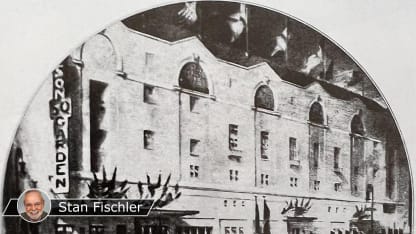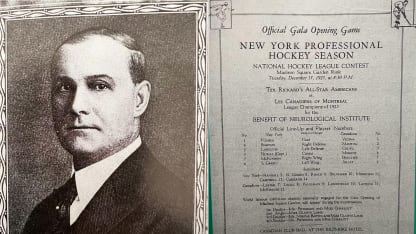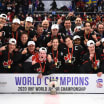Legendary hockey reporter Stan Fischler writes a weekly scrapbook for NHL.com. Fischler, known as "The Hockey Maven," shares his humor and insight with readers each Wednesday.
This week Fischler zeroes in on the construction of a massive new arena which would have a significant effect on the growth of the NHL and its first grand expansion into the United States almost a century ago.
Madison Square Garden set standard for NHL arenas in 1926
Larger crowds helped spur League's growth, expansion

By
Stan Fischler
Special to NHL.com
Thomas Duggan was a Montreal sportsman and visionary who was among the first to anticipate the growth potential of the NHL in the United States after World War I.
There were only four NHL teams in 1922-23, each located in Canada (Ottawa, Montreal, Toronto and Hamilton). Late that season, Duggan attended a League meeting and proposed the first significant expansion below the 49th parallel.
"He made a deal with NHL president Frank Calder," wrote historian Eric Zweig in his biography of Art Ross. "Duggan paid $2,000 for options on teams to be based in two of Boston, New York (Manhattan) or Brooklyn."
Duggan's spadework led to Boston becoming the first American city with an NHL team in 1924. Next on his agenda was New York where pro and amateur hockey had been confined to the relatively small St. Nicholas Arena across from Central Park.
As it happened, Manhattan's foremost sports palace, the second Madison Square Garden, had become obsolete and was to be replaced by a modern state of the art emporium just off Times Square.
The front man for MSG III was a flamboyant promoter from Texas, George Lewis "Tex" Rickard, who had successfully staged money-making boxing matches at the older Garden and arranged to have his new arena designed for the fight game and six-day bike races.
At the time, Rickard knew nothing about hockey and the proof was in the blueprints for the new Madison Square Garden which failed to provide for an ice-making plant. When Duggan made that discovery, he challenged Rickard to check out a hockey game in person.
Together they boarded the New York Central's Montreal Express and when it reached Windsor Station, they took a cab to The Forum on Ste. Catherines Street West.

Montreal Canadiens ace Howie Morenz was on his game that night and impressed Rickard with his pulsating end to end rushes. When Duggan asked him what he thought of the spectacle, Rickard shot back, "Okay, Tom, I'll put in an ice plant and we'll have a team in The Garden if you'll guarantee to have this guy Morenz there for the opener."
Duggan had himself a deal but there was a major matter of finding a hockey team to fill Manhattan's mammoth new arena. In this case money was no object since Duggan knew William "Big Bill" Dwyer, a noted New York City bootlegger.
"When Duggan told Dwyer about the possibilities of an NHL team, he was impressed," wrote New York sports columnist Frank Graham. "Big Bill figured that owning a hockey team would give him an aura of respectability,"
The next priority was finding a seller and that's when Lady Luck showed up in Hamilton, Ontario. The Hamilton Tigers were favored to win the Stanley Cup in 1925, but their players went on strike for higher pay before the postseason began.
NHL President Frank Calder suspended the Tigers and announced that the winner of the Maple Leafs-Canadiens series would be declared League champions. With that, Tigers owner Percy Thompson put a "For Sale" sign up and for a grand total of $80,000, Dwyer became an NHL owner.
"The cost to Dwyer was little more than that of a truckload or two of the Canadian whiskey he imported on a more regular basis," said hockey writer Eric Whitehead. "But of course, he had to smuggle the whiskey."
Like two perfectly meshed gears, Dwyer created an image as a sportsman and Rickard got a well-paying tenant for his arena, a team suitably named the Americans.
As Duggan had promised, the opening game at Madison Square Garden on Dec. 15, 1925, featured Howie Morenz and the Canadiens defeating the Americans 3-1. More than 15,000 seats were filled to capacity. And the hockey premiere was greeted with the same respect and heraldry as the debut of the Metropolitan Opera House.
Writing in the New York Sun, reporter Al Dayton waxed poetic about the evening's festivities.
"Never has a more glittering spectacle surrounded a sporting event in the city," Dayton wrote. "If this opening game is any criterion, the winter sport as fostered by the NHL has found a firm spot in the heart of Gotham's sportdom."
That same season, the Pittsburgh Pirates made their NHL debut in a totally contrasting venue. As opposed to Manhattan's glittering Garden, the Pirates' home -- Duquesne Gardens -- was a converted trolley car barn with a standing room capacity just under 6,000.
In fact, every other NHL rink had a seating capacity of under 10,000, the second largest being the Montreal Forum, designed for 9,000 seats.
The need for larger arenas became more evident when the Rangers became the second NHL tenant at The Garden in 1926 and turned into another instant success.
Tex Rickard's group eventually helped finance a new home for the Bruins which originally was named Boston Madison Square Garden. Its design was similar to the New York version but with a slightly smaller seating capacity.
Stan Saplin, New York's original hockey historian, pointed out that Manhattan's large arena proved to be a catalyst for other NHL building booms.
"Chicago and Detroit were in line for expansion franchises," Saplin said. "Once they saw how a big building like the Garden could succeed, they decided to follow suit."
When Detroit was granted a franchise in 1926, Olympia Stadium was designed with a seating capacity of 15,000. Chicago Stadium was built to accommodate more than 16,000 fans.
"If it wasn't for the Garden's success," Saplin asserted, "we might never have seen the kind of NHL growth that followed."
Eventually, the Montreal Forum was expanded and in 1931 and Maple Leaf Gardens opened for business in Toronto as the largest hockey rink in Canada.
"In retrospect," Saplin concluded, "Tom Duggan had the right idea about big-league hockey's growth; and Madison Square Garden set the standard for arenas in the NHL's first great expansion."

















